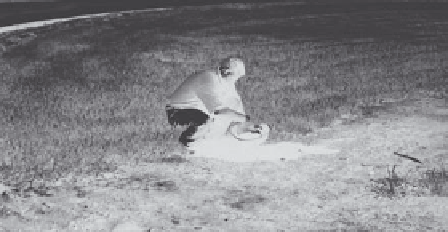Environmental Engineering Reference
In-Depth Information
With these objectives in mind, acceptable sampling techniques have been developed by
the USEPA. In addition, most states have published protocols for the collection of samples
for environmental purposes. An overview of common sampling methods for soil, ground-
water, sediment, and surface water are described in the following sections. In addition
to sample collection requirements and guidelines, transportation or shipment of samples
may be subject to Department of Transportation (DOT) rules described in Title 49 of the
Code of Federal Regulation (CFR), Parts 171 through 179. Therefore, applicable local, state,
and federal guidelines should be followed when conducting an environmental investiga-
tion at a specific site.
4.3.1 Soil Sampling and Description
Soil sampling is usually initiated during the Phase II investigation and involves collecting
surface and subsurface samples from borings drilled within and perhaps adjacent to RECs
identified in the Phase I ESA. The number and depth of the borings is dependent upon the
source and nature of contamination suspected to have been released. Soil samples are col-
lected using a wide variety of methods, including
• Collecting surface samples using a stainless steel trowel or other similar device
• Using manual hand augers to depths of approximately 1.5-3 m (5-10 ft)
• Hydraulically driving a probe called a Geoprobe
®
to depths of 6 m (20 ft)
• Excavating test pits using a backhoe or a similar type of equipment to depths
approaching 6 m
• Boring with hollow-stem augers to depths greater than 15 m (50 ft)
• Using Roto-sonic boring to depths of 30 m (100 ft) or more
• Using a Cone Penetrometer for depths greater than 30 m
4.3.1.1 Surface Sampling
Many investigations begin simply by collecting surface soil samples in each area of con-
cern. Figure 4.7 shows a location where a surface sample was collected. This location was
selected to represent a “worst-case” sample and to fingerprint the contaminant's release
area depicted by the area of heavy staining. The soil sample was collected using a stainless
steel trowel, then placed into a stainless steel bowl. The sample was then transferred into
appropriate sample containers before transport to the laboratory for analysis.
Person collecting
sample is wearing
protective gloves
Stainless
steel bowl
and trowel
Area of
stained soil
FIGURE 4.7
Surface soil sampling using a stainless steel trowel and bowl in an area of concern. (Photo by Daniel T. Rogers.)




Search WWH ::

Custom Search